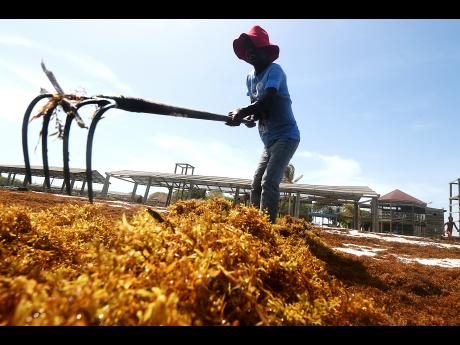Gleaner Editors' Forum | Sargassum choking Welcome Beach
Welcome Beach in Clarendon is the first major local casualty of the sargassum weed infestation, and scientists are warning that the situation is not likely to get better for Jamaica.
"Unfortunately, we are a collecting site and some of the fishing beaches, Welcome Beach in particular, which is exposed and you can't access it. It's not being used at all, and as bad as it is here, it's even worse in the eastern Caribbean," Donovan Brandon Hay, scientific officer with the Caribbean Coastal Area Management, disclosed during a recent Gleaner Editors' Forum.
He continued: "It can be 50 feet from shore that you get this build-up and then when that begins to decay we get fish kills. Especially in the mornings, because once they start to decay they reduce the oxygen in the water to a level where nothing can live in it.
"So it's a huge problem, one of these unintended or unforeseen consequences of climate change and changing cycles, and we need to prepare ourselves for more surprises like this because a solution isn't out there as yet."
In a release last month, the National Environment and Planning Agency (NEPA) warned that the brown-coloured seaweed would continue to affect the island's shoreline along the north and south coasts, but said it posed no threat to human life or environment.
NEPA further advised that the weed was likely to generate a foul odour once it starts to rot, and recommended leaving it on the beach as the simplest and least costly solution.
However, drifting in as it does from the east, accumulation of sargassum will continue to pressure the Portland Bight Protected Area, given its location which makes it a natural collecting site for floating mats of the ocean algae.
After accumulating for some time the seaweed becomes a solid mat, wreaking havoc for marine species such as turtle hatchlings which emerge from nests on the shore.
"Bizarrely, sargassum mats normally enhance the survival of turtle hatchling but the downside is that they also smother the beach, and the big, heavy tractors that you use to remove the stranded sargassum crush the eggs that are underneath. So it's a very complex disaster and it's likely to continue for some time to come," marine biologist Dr Karl Aiken told the forum.
The source of the bothersome seaweed affecting the Caribbean region is a giant mat about half the size of Brazil originating in the Atlantic Ocean, where it usually stays put. But it has been disturbed by the impact of climate change.
"The currents that drive it into a rotating circle, which is more or less fixed, have changed and are seasonal. About June, or earlier, the winds and current that hold it there falter and that allows bits of it to break off. The bits that break off, some of them are bigger than Jamaica, and of course they disperse and go past Trinidad, turn to the left by Barbados and are driven by the transatlantic currents to this area.
"By that time the mats break up into smaller pieces but some are several square kilometres when they approach the south coast. Where they are coming from is a self-regenerating because it's a plant and what does it need to survive? Sunlight and nutrients and these are in abundance," said Aiken.
He added that research conducted elsewhere suggests that in addition to elevated sea temperatures which enhance rapidity of growth, there is now more dust coming out of the Sahara Desert which brings more nutrients, creating a potential recipe for disaster.
"So you have nutrient-rich water and a rain of nutrients from the Sahara which is boosting growth even further, and with climate change being real and perhaps getting worse, the scenario for it stopping seems very unlikely. In other words, it's probably going to get worse rather than better," warned Aiken.



